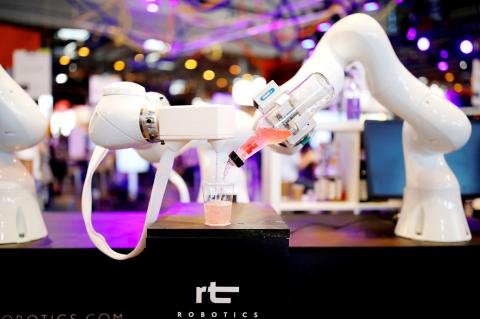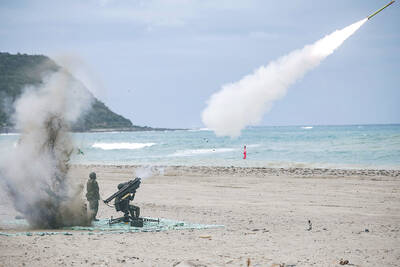As Tipsy methodically unfolds an arm to select a glass, retrieve ice and mix a drink, it’s all a far cry from the flashy swagger of Tom Cruise in Cocktail.
But then he doesn’t have the twinkle in his eye of a fictional Hollywood bartender — or any eyes at all, for that matter — because Tipsy is a robot. He won’t be able to swap sporting banter or offer relationship advice to lovelorn paramours but he mixes a mean Bloody Mary for his customers at his shopping mall bar in Las Vegas.
Tipsy is the logical conclusion of an increasingly space-age service industry that has already given us the mechanical cupcake dispenser and automated pizza restaurants. “Monsieur” and “Tended Bar” are two brands among a new wave of machines that can whip up cocktails at sports arenas, hotels and other venues for a fraction of the cost of a human server.

Photo: REUTERS
The concept — essentially a vending machine with a boozy kick — couldn’t be more straightforward: select your tipple from a digital menu and wait moments for that little slice of liquid gold to drop into a plastic beaker.
COSMOPOLITAN
The idea is not unique to the US — Parisian start-ups Realtime Robotics and Kuantom have also produced bartending automatons, while vending machines for canned alcohol are common on the streets of Tokyo.
In the US, “self-service” venues such as L.I. Pour House Bar and Grill in Long Island have embraced automation by allowing customers to pull their own pints and pay via a computer terminal. The boss there, Anthony Pallino, points to the need to economize at a time when the minimum wage is set to rise to US$15.
“If you needed five or six servers on a normal night, now you need four,” he says, estimating savings of thousands of dollars a year with each electronic server. Automation always brings with it concerns over unemployment among increasingly obsolete humans, yet back in Las Vegas, customers seem to have taken to Tipsy.
“Robots and automation are definitely a quicker and an easier way. The drinks are always the same. You can add a little extra if you want to for the machines, so it makes it really cool,” says John Woodall, a tourist from Tennessee. “This is the future,” adds Las Vegas resident Mauricio Letona — but not everyone is sold on the technological advance. French tourist Antoine Ferrari thinks it is “cooler to have a drink when there is someone behind the bar,” although he ackowledges Tipsy’s unique selling point, the novelty of a “slightly futuristic” drinking experience.
A HUMAN TOUCH
Italian Rino Armeni, president of Robotic Innovations and owner of the bar in which Tipsy works, is conscious of the imperative to retain the human element of going for a drink.
“The first thing that I said to my staff when we opened, I said ‘Look, remember one thing: these robots are entertainers, but people will come back because of you,’” he says.
“I don’t want to go away from human nature, the human rapport. That will never change.”
Experts expect jobs to disappear as this latest front opens in the race for automation, but say there is little chance that the trendy, tattooed mixologist will ever be a relic of the past. “Consider the job of bartender,” says Michael Dyer, emeritus professor of computer science at University of California, Los Angeles (UCLA). “The bartender has numerous tasks: chat with the clients, decide when to not serve them more drinks, make sure they don’t reach over the bar and steal bottles or drinks, collect payment and give back change.” Androids can perform few of these tasks to a human level of competence, he adds, so choosing whether or not to automate will always be a simple question of balancing the costs and benefits.
A machine may cost a one-off US$100,000 to perform just one limited task while a human barman might cost US$30,000 a year but offer a much wider range of skills, he argues.
While the bionic barman is already a reality, the robotic cordon bleu chef remains a distant dream, says Richard Korf, another professor at UCLA.
“You can automate what a barman does — there’s a limited number of ingredients — but it might not work for a chef who uses a lot of ingredients, different skills, different tools, cutting slicing, whipping, mixing,” he argues. “That would be a huge challenge.”
“The other question is: would you want that? A lot of the experience of going to bar is talking to the bartender. They are often attractive and talk to customers, you can tell them your problems et cetera.”
The ideal places for automated bartenders, he maintains, would be venues where the goal is not social interaction, such as concert halls. “There will be situations where using these robots will increase the quality of service, in a busy, noisy environment, for example,” says Pamela Rutledge, an expert in media psychology. But she adds that being recognized and acknowledged by the staff, especially at the local neighborhood bar, “creates a kind of social connection, it makes you feel like you belong.”

In late October of 1873 the government of Japan decided against sending a military expedition to Korea to force that nation to open trade relations. Across the government supporters of the expedition resigned immediately. The spectacle of revolt by disaffected samurai began to loom over Japanese politics. In January of 1874 disaffected samurai attacked a senior minister in Tokyo. A month later, a group of pro-Korea expedition and anti-foreign elements from Saga prefecture in Kyushu revolted, driven in part by high food prices stemming from poor harvests. Their leader, according to Edward Drea’s classic Japan’s Imperial Army, was a samurai

The following three paragraphs are just some of what the local Chinese-language press is reporting on breathlessly and following every twist and turn with the eagerness of a soap opera fan. For many English-language readers, it probably comes across as incomprehensibly opaque, so bear with me briefly dear reader: To the surprise of many, former pop singer and Democratic Progressive Party (DPP) ex-lawmaker Yu Tien (余天) of the Taiwan Normal Country Promotion Association (TNCPA) at the last minute dropped out of the running for committee chair of the DPP’s New Taipei City chapter, paving the way for DPP legislator Su

It’s hard to know where to begin with Mark Tovell’s Taiwan: Roads Above the Clouds. Having published a travelogue myself, as well as having contributed to several guidebooks, at first glance Tovell’s book appears to inhabit a middle ground — the kind of hard-to-sell nowheresville publishers detest. Leaf through the pages and you’ll find them suffuse with the purple prose best associated with travel literature: “When the sun is low on a warm, clear morning, and with the heat already rising, we stand at the riverside bike path leading south from Sanxia’s old cobble streets.” Hardly the stuff of your

Located down a sideroad in old Wanhua District (萬華區), Waley Art (水谷藝術) has an established reputation for curating some of the more provocative indie art exhibitions in Taipei. And this month is no exception. Beyond the innocuous facade of a shophouse, the full three stories of the gallery space (including the basement) have been taken over by photographs, installation videos and abstract images courtesy of two creatives who hail from the opposite ends of the earth, Taiwan’s Hsu Yi-ting (許懿婷) and Germany’s Benjamin Janzen. “In 2019, I had an art residency in Europe,” Hsu says. “I met Benjamin in the lobby